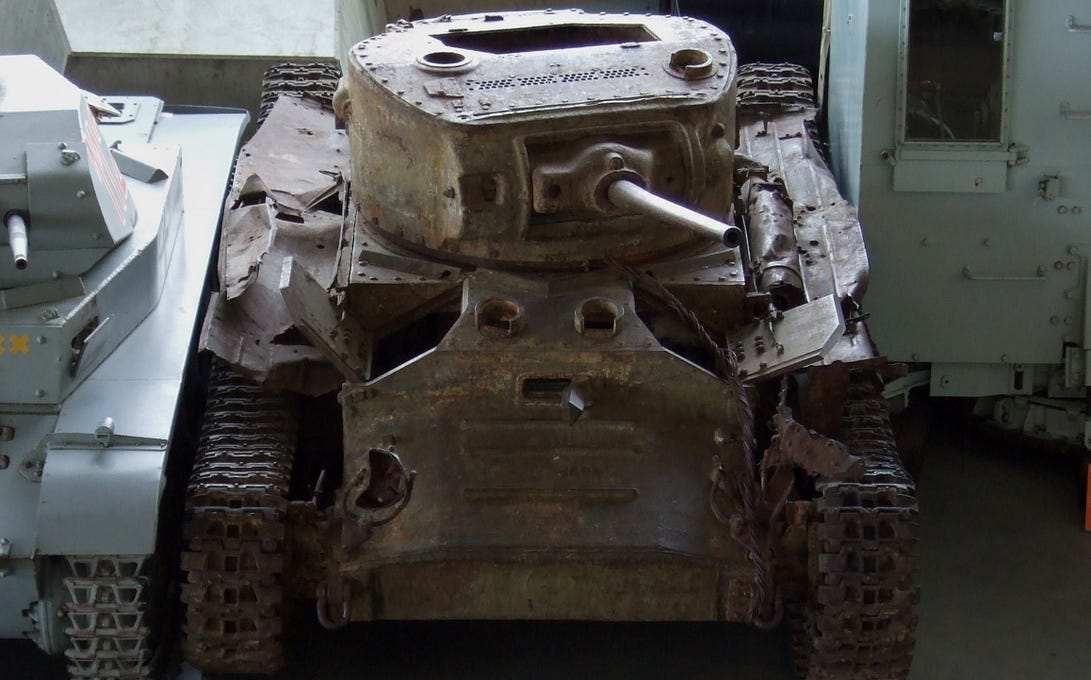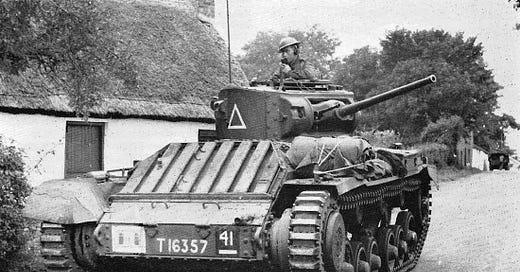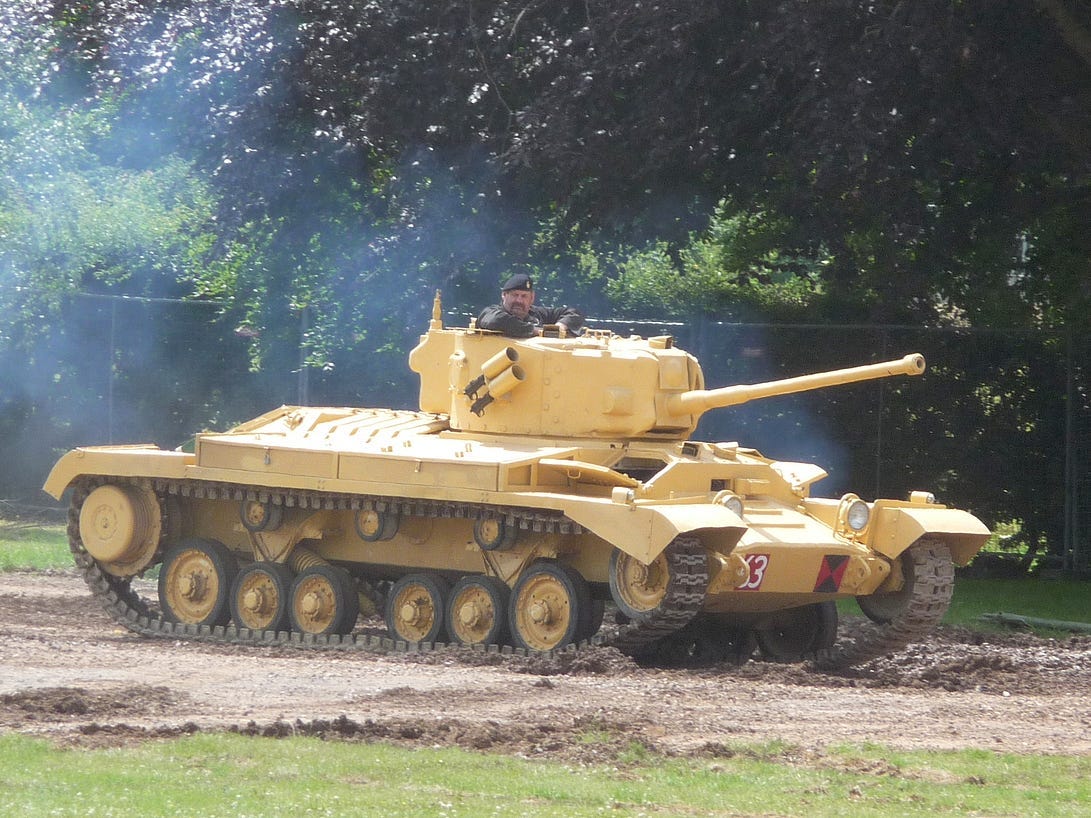by SEBASTIEN ROBLIN
On Oct. 11, 1941, 11 merchants ships from Arctic convoy PQ-1 entered the harbor of Arkhangelsk in northern Russia. It was the second of dozens of Allied convoys that would brave the U-boat-infested waters of the North Sea to deliver vital military aid to the Soviet Union.
The USSR was still reeling from the Nazi invasion that launched that summer.
The ships carried 193 disassembled Hawker Hurricane fighters, nine Matilda II heavy tanks and 11 Valentine Mark II tanks.
The Valentines had emerged from the Vickers Elswick factory in Newcastle-upon-Thyne a few months earlier for £10,000 apiece.
With 8,275 built, the Valentine tank was the most numerous British tank of World War II. Canadian and British factories shipped nearly half (3,782) to the the Eastern Front for service with the Red Army.
450 of those Valentines sank into watery graves, victims of German U-boats, mines and bombers. But the surviving 3,332 Valentine served the Red Army throughout World War II.
We know what the Red Army thought about its British Valentines thanks to Soviet archives that Yuri Pasholok translated and which Peter Samsonov expanded on at the website Tank Archives.
The Valentine originated as a private venture by Vickers. The company wanted to adapt its A10 Cruiser tank into a more heavily-armored infantry-support tank.
The final design retained the A10’s hull while introducing a two-man turret in which the tank commander doubled as a loader.
Vickers supposedly submitted the so-called Infantry Tank Mark III to the War Office on Valentine’s Day 1938. The first production vehicle rolled off the assembly line in May 1940—too late to participate in the Battle of France.
The Valentine was full of contradictions. Its 60 millimeters of affordable riveted armor left it near impervious to early-World War II tank guns. But due to its compact dimensions—just 2.6 meters wide and 2.3 meters tall—it weighed only 17 tons compared to, say, the Sherman medium tank’s 30 tons.
Ironically, the Valentine infantry tank was poorly armed for fighting infantry. Its 40-millimeter two-pounder gun lacked high-explosive ammunition because of ill-conceived British doctrine, which maintained that machine guns were adequate for combating infantry.
The Valentine had a co-axial Besa machine gun in the turret, but machine-gun fire was no substitute for explosive shells when it come to rooting out dug-in troops or dueling with anti-tank artillery at long range.
The tank’s AEC petrol or diesel motor limited its speed to a stately 15 to 20 miles per hour on roads, and early models lacked range until external fuel tanks were bolted on.
But the Valentine had relatively good all-terrain mobility, and excellent reliability over long distance. Compared to heavier Matilda tanks and faster but temperamental Cruisers and Crusaders, the Valentine was the slow-but-steady tortoise that won the race.
Four days after PQ-1's arrival, training on the foreign vehicles began at Kazan. Then on Oct. 31, 1941 convoy PQ-2 brought in an additional 84 Valentines plus 22 expert mechanics to train Soviet maintainers.
However, the Soviets were dismayed by the “many small defects” they found in early Valentines. Many had been filled with water instead of anti-freeze for coolant, resulting in 27 of the Valentines in PQ-2 arriving with frozen, cracked pipes and ruptured radiators.
Furthermore, roughly a third of the tanks were delivered without tarps or tool and towing cables and some even lacked crew machine guns. And they came with only five or six full loads of two-pounder shells—and no spare gun barrels.
The Soviet registered complaints with the British attaché in Moscow. Later Valentines arrived with anti-freeze and winter-resistant oil lubricants and batteries plus nine full loads of ammunition each.
By November 1941, German Panzers were dangerously close to Moscow, so the Red Army threw its newly-acquired Valentines into the defense of the city. A German report reveals three Valentines were knocked in action on Nov. 25, 1941.
Afterward, a performance review by the Red Army’s 131st Independent Tank Battalion praised the “small but powerful” British tank for its spalling-resistant armor, forgiving handling, responsive suspension and quiet and reliable engine.
However, it knocked the Valentine for poor snow-driving performance, jam-prone gearbox and weak tracks and wheels. Above all, Soviet tankers hated the lack of high-explosive rounds.
The same report also implied the Soviet tankers loaded the Valentine’s two-inch smoke mortar with “domestic 50-millimeter [mortar] rounds” which proved effective against infantry. They also improved snow performance by welding metal spurs onto the tracks.

Modding the Valentine
Still, the lack of H.E. shells deeply bothered the Red Army, which experimentally refit a Valentine with a domestic 45-millimeter gun. The prototype performed well, but the army didn’t have cannons to spare and killed the project.
An attempt to adapt fragmenting 40-millimeter Bofors anti-aircraft shells also came to naught. Soviet tankers would have loved to install an 85-millimeter gun, but there was too little room in the Valentine’s turret.
More successful were field modifications to bolt-on an additional 30-millimeter plate of frontal armor, helping the Valentine maintain a defensive edge versus longer-barrel German 50- and 75-millimeter tank guns that entered service in 1942.
Though officials denied a formal request to implement the upgrade fleet-wide, photos reveal troops field-modifying many Valentines.
Soviet crews preferred the Valentine over more technically-challenging Lend Lease tanks—this despite the Valentine’s flaws. A March 1943 report from the Soviet 10th Army revealed that of 83 Valentines the army lost in a three-week period, only 13 percent were victims of mobility problems on the march.
By contrast, a full third of Soviet-made T-34s fell out on long marches.
While 19-percent of lost Valentines were irreparable, 62 percent could be made functional again with local repairs. 18 percent required fixes at a regional depot.
In mobility trials, the Valentine proved it could ford 1.4-meter-deep rivers (though it flooded when it tried backing up), traverse 32-degree slopes and maintain decent off-road speeds of up to 12 miles per hour.
A Soviet manual deemed the Valentine suitable for carrying up to six submachine gun-armed “tank riders.”
In Alexander Hill’s The Red Army and the Second World War, Boris Koshechkin, commander of a Valentine platoon at the Battle of Kursk, described it as being roomy “like a restaurant.” He likewise praised the Valentine’s radios, which allow the crew to “engage in combat the right way.”
This praise perhaps reflected the comparatively poor ergonomics and sparsity of radios in otherwise beefier Soviet tanks.
A May 1942 letter from Soviet premier Joseph Stalin to Foreign Minister Vyacheslav Molotov in London ended with this missive. “Tell the British to send more fighters and tanks, especially Valentines.”
Fortunately, a new production line at the Angus Shops of Montreal was churning out the first of 1,420 Canadian Valentines. Just 32 served in the Royal Canadian Army in a training role—the rest shipped off to Russia.
By then, British factories were manufacturing Mark IV Valentines with quieter and more reliable GMC 6004 diesel engines and transmission, four-person-crew Mark III Valentines with room for a loader at the expense of side armor and Mark V models combining both features.
The Canadians built two variants of the Mark IV tank, the Mark VI and modestly improved Mark VII. Canadian Valentines used more cast parts and Browning instead of Besa machine guns.
The long-barrel Mark IX
In 1942, Soviet tests found the Valentine’s two-pounder shells shattered ineffectually against the frontal armor of the later-model German Panzer III tanks and StuG assault guns.
Fortunately, that year the United Kingdom began producing the Mark IX Valentine, which boasted a 57-millimeter six-pounder gun, three Mark IV periscopes, more powerful 165-horsepower diesel engines and a jettisonable external fuel tank that increased range by 90 percent.
The 50-calibers-long six-pounder generated a higher muzzle velocity than did even the 75-millimeter guns on the Cromwell and Sherman tanks, and thus posed a greater threat to heavier German Panzers.
The first of 927 six-pounder-armed Valentines arrived with convoy JW-53 in February 1943. Tank units in Allied-occupied Iran also transferred Mark IXs to the Red Army.
But the six-pounder also lacked high-explosive shells. Worse, the Mark IX gave up its co-axial machine gun and loader to make room for the bigger gun. The old smoke mortar was replaced by an unpopular external grenade launcher. Only a pintle-mounted Bren anti-aircraft machine gun remained for close defense—if the commander dared poke his head above the hatch.
One who apparently did so was 20-year-old Lt. Valentine Dimitrievich Pashirov, commander of a Mark IX platoon in the 74th Tank Regiment who posthumously was named a Hero of the Soviet Union for his deeds at the Battle of Dnieper in 1943.
“In battles for Khotiv [near Kiev, Ukraine], comrade Pashirov pursued the retreating enemy with his tanks, destroying up to a company of German soldiers and officers, up to 10 cars, up to 50 carts and up to 10 machine-gun nests,” his citation reads.
“Personally, he destroyed two enemy tanks with his tank’s gun. His tank was disabled, but he did not leave the tank, and kept fighting in place. The Germans attempted to capture the tank, but comrade Pashirov met them with a hurricane of fire, covering the ground with enemy corpses.”
“Comrade Pashirov fought for five hours without giving up his tank, and met the death of heroes on the battlefield.”
Allied factories eventually restored the coaxial machine gun by shaving away side armor in a limited run of Valentine Mark Xs, shipping nearly half (64 tanks) to the Soviets in 1944.
Still, a Soviet report bitterly complained that the Mark IXs were only usable as tank-destroyers. But in late 1943, an unexpected remedy came in the form of 650 American Lend-Lease T-48 tank-destroyers—basically M-3 half-tracks toting 57-millimeter guns.
Those did come with high-explosive shells that were compatible with the six-pounder. Thus the Soviets finally sourced anti-infantry shells for their Valentines. This “saved the Valentine,” according to Pasholok.
The British were mystified by Soviet enthusiasm for the Valentine, as Steven Zaloga described in Soviet Lend-Lease Tanks of World War II.
“It is not known why the Russians appears so eager to get Valentines, even when armed with only a two-pounder gun,” reads a 1943 War Office memo Zaloga cited. “It is of course a very reliable tank but cannot be considered a modern weapon.”
The director of armored vehicle development concurred that by then it was “definitely obsolete.” “Everything that shoots goes through its armor,” the director added. “The six-pounder Valentin is a bastard, having no machine gun.”
But the British continued production into 1944 solely to satisfy Soviet requests. The Red Army found the Valentine a superior substitute for its vulnerable T-70 and T-80 light tanks—so it discontinued their production and used Valentines in their place.
Thus Valentines came to be considered light tanks, and independent regiments were accordingly assigned to support Red Army cavalry divisions.
The 151st Independent Tank Regiment, initially equipped with six Mark IX and four Mark III Valentines plus 10 M-3A1 light tanks, battled intensely for the city of Lanzhot in Czechoslovakia.
The regiment ended up “losing one Valentine IX and two Valentine IIIs burned up and one Valentine IX and one M-3 light [tank] knocked out,” Pashalok wrote. “One enemy tank was destroyed with return fire, one knocked out, and up to 80 soldiers and officers plus one armored troop carrier were destroyed.”
“Fighting for Trvonice cost two knocked-out Valentines and two M-3 lights. In return, the Soviet tankers destroyed 145 soldiers and officers, an anti-tank gun, and an [armored personnel carrier].”
“During its fighting career [between March 26 and April 19, 1945], the regiment claimed five burned up and one knocked out Panther tanks and 380 enemy soldiers and officers,” Pashalok concluded.
Another Soviet after-action report on April 29, 1945—just a week before the German surrender—listed 10 Mark IX and three Mark III Valentine tanks in the 198th Tank Regiment, mixed in with 17 T-34s tanks and Su-76 and Su-100 assault guns.
During a 25-mile advance from Barsdorf to Rheinsberg, north of Berlin, the unit claimed to have inflicted 134 casualties, liberated 725 prisoners and destroyed 10 armored vehicles, 38 mortars and artillery pieces, 123 cars … and 100 bicycles.
Valentines were even present for the very last major ground offensive of World War II, when Soviet forces assaulted the Japanese Kwantung Army Group occupying Mongolia and northern China. The Manchurian Front counted in its ranks 81 Valentine tanks (78 functional), including two 10-vehicle companies of special Valentine bridge-laying vehicles.
Following the Japanese defeat, the Red Army reportedly transferred some of the Valentines to the Chinese People’s Liberation Army. By then the quirky Valentine tank had made up for its flaws with sheer reliability and robustness.






